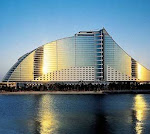Thursday, March 12, 2009
Barcelona
Barcelona is the capital of Catalonia, the north-eastern region of Spain, surrounded by the Pyrenees and the Mediterranean Sea. The city is not only one of the busiest ports of this sea, but it is as important as Madrid and the other European capitals, also from a cultural, commercial and sporting point of view. Its main characteristic, also due to its geographic position is its passion for innovation and modernity. The most famous thoroughfare of Barcelona, Las Ramblas, goes through the old city, one of the most important and interesting medieval centres in Europe. Well known all over the world as the Gothic district, it still preserves the original splendour of the cathedral, the ancient royal palace and several buildings are of great value and interest. The Museum Frederic Marès is part of the complex that includes the Royal Palace. The building that houses it was occupied in the XIII century by the bishops and in the XIV century by the counts of Barcelona, in the XV century by the judges and finally, in the XVIII century by nuns who left only in 1936. The sculptor Marès, who owned a little apartment inside the building, opened the museum in 1948. The Museum houses a surprising collection of sacred Roman and Gothic art. In the southern part of the Gothic District we can see the beautiful Town Hall (Casa de la Ciutat) that was built in neo-classic style in the XIV century. Right in front of the Town Hall you can see Palau de Generalitat, seat of the Government of Catalonia since 1403. One of the compulsory stops for those who visit Barcelona is certainly the Pablo Picasso Museum. Opened in 1963 it is housed by three different buildings: the Baroque Meca and the Medieval Bereguer d’Aguilar and Barò de Castellet. The 3000 works are divided into three sections: paintings and drawings, engravings and china. It is impossible not to stop and observe the Cathedral of Barcelona. It was built in Gothic style with a Roman chapel in the year 1298 with Jaume II on the foundations of a Roman temple and a Moresque mosque and was finished only in the XIX century. . The inside is in Gothic-Catalan style and is made of a single nave surrounded by 28 chapels situated among the columns which support the ceiling that is 26 metre tall. The crypt under the main altar is particularly interesting. In fact inside we can find the alabaster sarcophagus of the year 1339 of Sant’Eulalia, patron saint of the city who was a martyr of the Romans in 300 AD It is worth moving to the northern area of the Old City to be amazed by the Palau de Musica Catalana. The Palace was finished in 1908 on a site where a monastery was destroyed in 1800. Its characteristic is that it is the only concert room that is illuminated by natural light in Europe. Las Ramblas comes from the Arab “ramla” ,or “dry seasonal river bed". It links Placa de Catalunya to Port Vell. The Ramblas is always full of life: all kinds of stalls, bird cages and street artists attract a lot of people above all at night and during the weekend. It is here that we find La Boqueria, the most colourful and lively food market in Barcelona. Flower, fruit and vegetable, meat and fish stalls attract not only the eye but also the mere scent of them will make your mouth water. But do not worry if you’re hungry because in the Ramblas you will find bars, restaurants and all kinds of place where you will be able to enjoy a pleasant break. A little farther you will see Placa Reial. It is lively and crowded and dates back to the year 1850: it is surrounded by Neo-classic street-lamps designed by Gaudì. In the Illa de la Discordia you can see the most famous group of modernist buildings, often the houses of the most famous exponents of Modernism itself. One of these is Casa Amatller that was designed by Puig i Cadafalch in 1898. Its façade is absolutely unique, with Moresque windows and Gothic iron structures. The incomparable sloping roof is completely covered in tiles. This building nowadays houses the Institut Amatller d’Art Hispànic. In the Passeig de Gràcia you can admire Casa Milà called la “pedrera”, the stone quarry. UNESCO declared it Mankind’s Heritage in 1984. It is a later work by Gaudì and it represents his genius and exuberance. It was built between 1906 and 1910 and, at the beginning, was criticised and ridiculed by the intellectuals of the time because it was far from the usual architectonic principles. The palace is made up of 8 floors and two circular courtyards. The wrought iron balconies are beautiful, the decorations that look like seaweed on the white stone walls remind the observer of the waves of the ocean. To better admire this new form of art we cannot but visit the most bizarre church in Europe: la Sagrada Familia. In 1883 Antoni Gaudì, one of the most extraordinary and innovative architects of the XX century and the greatest exponent of Modernism, was chosen to complete a neo-Gothic cathedral that was started the year before. This became his ultimate aim: he lived there for 16 years and when he died he was buried in the crypt. His project was impressive: a huge modernist building rich in symbolism and natural evocations. It was made up of three façades, seven aisles and several towers. Actually only two façades were finished, the Nativity by Gaudì himself and the Passion and Death in 1980 by Joseph Maria Subirachs.. Apart from these also the apse, some bell-towers, the sides and the left transept were finished. The roof though was completely missing. The construction is still going on, even if slowly, thanks to the offers of the church-goers and the public financial aid: by the year 2007 the roof should be finished, while for a complete end to the works we will have to wait for at least another 50 years. The Montjuic hill houses the largest recreational area in Barcelona with museums, art galleries, amusement parks and all kinds of bar and clubs that make it lively and busy both during the day and at night. It is certainly one of the most spectacular panoramic views of the city, it is 213 metres above the commercial port. On top of the hill you can see the castle of the same name, from where you can enjoy the view of the port. The first fortress was built in 1640 but was destroyed in 1705 by Philip V. The Bourbons built the castle on the remains in the shape of a star that we can admire today. It now houses a military museum with ancient weapons and interesting models of Catalan fortresses. You can reach mount Tibidabo with the last existing tram in Barcelona or with the funicular cable car. Inside you will find the Parc d’Atraccion, inaugurated in 1908 and renovated in the 80s. Beside the extraordinary and modern attractions, there are some old ones full of charm and history. On top of the mountain you can find the Church of the Sacred Heart that was built between 1902 and 1911. You can reach the huge statue of Christ on top of the Church by lift.Parc Guell is certainly the most coloured of Gaudì's works. Commissioned in 1890 by the count Eusebi Guell, it was said to house a sort of garden city 20-hectare wide. Actually what we can see today is only a part of the original project Certainly the artist gave rein to all of his imagination: mazes, fountains, caves where it is difficult to distinguish dream from reality. Do not miss the Room with 100 columns, made up of 84 asymmetrical columns and made cheerful and sparkling by precious glass and china mosaics. Above it you will see the Gran Placa Circular, an open space with mosaics including a wave-shaped bench that competes for being the longest in the world.
Subscribe to:
Post Comments (Atom)














No comments:
Post a Comment